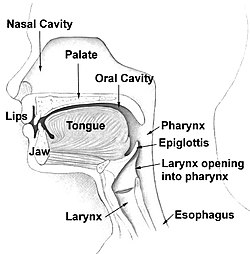Oropharyngeal cancer
| Oropharyngeal cancer | |
|---|---|

Head and neck.
|
|

Pharynx
|
|
| Details | |
| Artery | pharyngeal branches of ascending pharyngeal artery, ascending palatine, descending palatine, pharyngeal branches of inferior thyroid |
| Vein | pharyngeal veins |
| Nerve | pharyngeal plexus |
| Identifiers | |
| MeSH | A03.556.750 |
| Code | p_16 |
|
Anatomical terminology
[]
|
|
| Oropharyngeal squamous cell carcinomas | |
|---|---|
| Classification and external resources | |
| ICD-10 |
C09-C10 C01,C02.4,C05.1 |
Oropharyngeal cancer is a disease in which malignant cells form in the tissue of oropharynx. The oropharynx is the middle part of the throat that includes the base of the tongue, the tonsils, the soft palate, and the walls of the pharynx. Oropharyngeal cancers can be divided into two types, HPV-positive, which are related to human papillomavirus infection, and HPV-negative cancers, which are usually linked to alcohol or tobacco use.
The possible signs of oropharyngeal cancer are:
The risk factors that can increase the risk of developing oropharyngeal cancer are:
High-risk lesions:
Medium-risk lesions:
Low-risk lesions:
Patients with HPV-mediated oropharyngeal cancer tend to have higher survival rates. The prognosis for people with oropharyngeal cancer depends on the age and health of the person and the stage of the disease. It is important for people with oropharyngeal cancer to have follow-up exams for the rest of their lives, as cancer can occur in nearby areas. In addition, it is important to eliminate risk factors such as smoking and drinking alcohol, which increase the risk for second cancers.
The cancer can spread three ways:
Abnormal cells are found in the lining of the oropharynx. These may become cancer and spread into nearby normal tissue.
Cancer has formed and is 20 mm or smaller and has not spread outside the oropharynx.
Cancer has formed and is larger than 20 mm, but not larger than 40 mm. Also, it has not yet spread outside the oropharynx.
Cancer has spread to other parts of the body; the tumor may be any size and may have spread to lymph nodes.
Oropharyngeal squamous cell carcinomas is a type of head and neck cancer that begins in the oropharynx, the middle part of the throat that includes the soft palate, the base of the tongue, the tonsils, and the side and back wall of the throat. Squamous cell cancers of the tonsils are more strongly associated with human papillomavirus infection than are cancers of other regions of the head and neck.
...
Wikipedia
